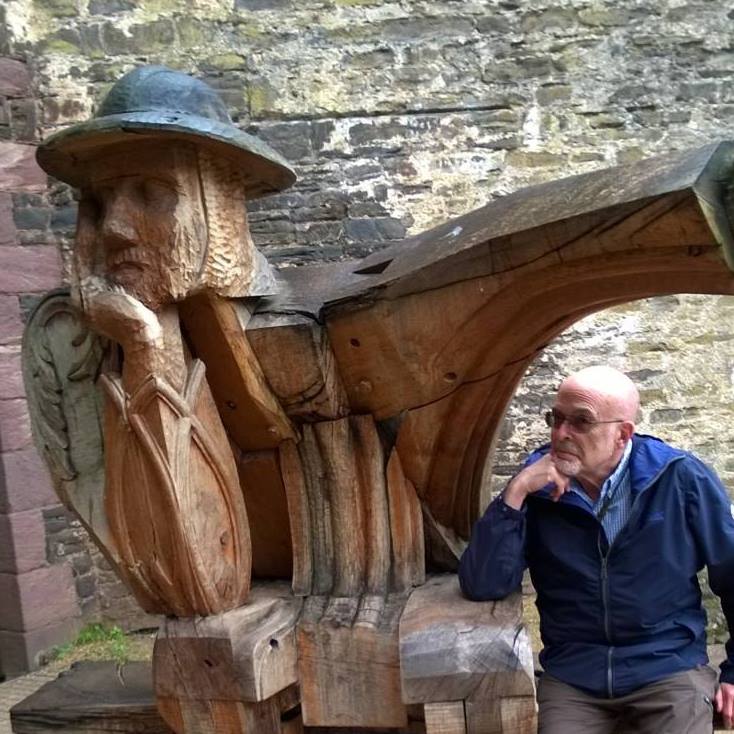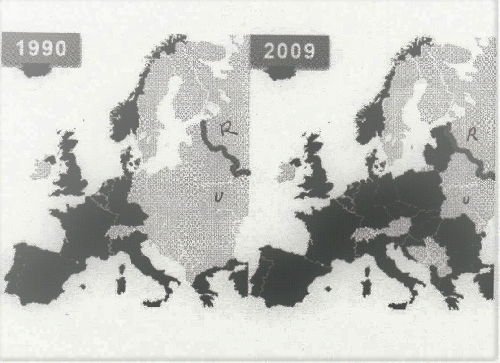
Locator map for separatist Donbass and Crimea (annexed by Russia)
(Image by Wikipedia (commons.wikimedia.org)) Details DMCA
"Russia's aggression today not only threatens Ukraine. It also threatens Europe. It threatens the international order this body is charged with upholding. An order that, if it stands for anything, stands for the principle that one country cannot... make another country's people live under a government they did not choose."
In presenting herself as an apostle of "the international order," she displayed either a shocking ignorance of U.S. history or disrespect for the many people in her UN audience who would be painfully aware of American imperialism in Latin America and elsewhere. The list of governments overthrown by the U.S. is long and repetitive. For instance, the people of Chile had to "live under a government they did not choose," when the CIA enabled a military coup in 1973 that resulted in 17 years of forced disappearances, political imprisonment and torture. American support for right-wing regimes in the Northern Triangle (El Salvador, Guatemala and Honduras) created violent failed states that drove hundreds of thousands of migrants to seek refuge at our southern border in the last few years.
The U.K. and U.S. have claimed that Russia was developing plans to install a pro-Russian leader in Ukraine. Emily J. Horne, the spokeswoman for the U.S. National Security Council, said that "this kind of plotting is deeply concerning. The Ukrainian people have the sovereign right to determine their own future, and we stand with our democratically elected partners in Ukraine" (NYT, 1/22). She was able to say this with a straight face despite the heavy involvement of the U.S. in the 2014 overthrow of Ukraine's democratically elected President Viktor Yanukovych.
In late 2013 and early 2014 a wave of large-scale protests broke out across Ukraine against the refusal by President Yanukovych to sign a political association agreement with the European Union. These protests culminated in massive, increasingly violent riots in Kyiv's Maidan Square. Victoria Nuland, Obama's Assistant Secretary of State for European and Eurasian Affairs, famously went to Maidan Square to hand out bread and cookies to the rioters. Yanukovych fled Kyiv on Feb. 22, ending up in exile in Russia. As Ted Galen Carpenter wrote in an article titled "America's Ukraine Hypocrisy" (Cato Institute, 8/6/17),
"The extent of the Obama administration's meddling in Ukraine's politics was breathtaking. Russian intelligence intercepted and leaked to the international media a Nuland telephone call in which she and U.S. ambassador to Ukraine Geoffey Pyatt discussed in detail their preferences for specific personnel in a post-Yanukovych government."
In Crimea, where two-thirds of the population is ethnically Russian, the Crimean parliament reacted to the U.S.-sponsored coup by voting on March 6, 2014, to secede from Ukraine and join the Russian Federation. A referendum on March 16 returned a 97% vote in favor of joining Russia. This result was not accepted by Ukraine or most other nations. But Gallup and other polls record overwhelming approval of Russian annexation by Crimeans.
In May of 2014 pro-Russian separatists in the Donbas region of eastern Ukraine declared the Independent People's Republics of Luhansk and Donetsk, which are not yet recognized by Russia or any other state. This region is the birthplace of former President Yanukovych, and is primarily Russophone with a large ethnic Russian minority. It continues to be a war zone between Ukrainian government troops and separatists supported by Russia. The death toll now stands at 14,000 in what has become a trench war along a 420-km-long front line cutting through densely populated areas.
To understand the current crisis over U.S. claims about the threat of Russian troops at the Ukrainian border, we have to keep in mind the ongoing violence and instability from the Ukrainian civil war in Donbas caused by the American-sponsored overthrow of Yanukovych. Since 2014 there have been intermittent efforts to implement the provisions of the Minsk Protocol negotiated by Ukraine, Russia and the Organization for Security and Co-operation in Europe (OSCE), aided by France and Germany. The protocol sought to establish a new political relationship between Kyiv and the Donbas region with greater autonomy for the Donbas. So far, the political will has not been strong enough to implement these necessary changes. From the Russian point of view, the instability is desirable because it blocks NATO from incorporating Ukraine and creating a military threat on Russia's border. This stalemate is complicated by unwillingness of the U.S. and EU to recognize that Russia's annexation of Crimea is a permanent fait accompli.
The other major cause of the current crisis is the relentless eastward expansion of NATO shown in the map below. Dark areas indicate NATO territory and expansion from 1990 to 2009. 'R' is Russia and 'U' is Ukraine.
(Image by commons) Details DMCA
When NATO was formed in 1949, its main purpose was collective security against the Soviet Union (USSR). As a counterweight to NATO the Soviet Union in 1955 joined with seven Eastern European communist republics (Albania, Bulgaria, Czechoslovakia, East Germany, Hungary, Poland, and Romania) to form the Warsaw Pact.
On the 1990 map above, the space between NATO and Russia was taken up by two tiers of republics: the Warsaw Pact nations on the west and the Baltic States, Belarus, Ukraine and Moldova, on the east. The eastern republics were (with Russia) part of the Soviet Union (USSR). When the Soviet Union dissolved in 1991, a space half the size of Europe yawned between Russia and NATO. It contained newly independent former members of the Warsaw Pact and of the USSR, all of whom had to reorient themselves in relation to Western Europe and the Russian colossus to the east.
As we can see from the 2009 map, NATO did not go away once the dissolution of the Soviet Union and Warsaw Pact made its original purpose obsolete. Instead, it expanded to include many former Warsaw Pact countries as well as a part of the Soviet Union--the Baltic States (Lithuania, Latvia and Estonia). By including the Baltic States, NATO brought the military umbrella of the United States right up to the Russian border. Imagine the reaction of the U.S. government and people if the Warsaw Pact still existed today and Mexico joined it. Mexico would suffer the fate of Cuba.
George F. Kennan (1904 - 2005), a very influential American diplomat and historian, was a principal architect of the cold-war policy of "containment" toward the Soviet Union under Truman. On Feb. 5, 1997, he wrote an op-ed in The New York Times remarking that it seemed to have been "somehow and somewhere decided" within the Clinton administration "to expand NATO up to Russia's borders." He and many others "with extensive and in most instances more recent experience in Russian matters..." shared the view "that expanding NATO would be the most fateful error of American policy in the entire post-cold-war era." His reasons for saying this are even more relevant today:
(Note: You can view every article as one long page if you sign up as an Advocate Member, or higher).






